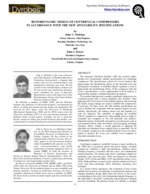Papers
“Rotordynamic Design of Centrifugal Compressors in Accordance with the New API Stability Specifications,” |
Abstract
The American Petroleum Institute (API) has recently implemented new rotordynamic stability specifications for centrifugal compressors. The specifications consist of a Level I analysis that approximates the destabilizing effects of the labyrinth seals and aerodynamic excitations. A modified Alford’s equation is used to approximate the destabilizing effects. If the compressor fails the Level I specifications, a more sophisticated Level II analysis is required that includes a detailed labyrinth seal analysis. Five modern high-pressure example centrifugal compressors are considered along with a classic instability case, Kaybob. After applying API Level I and Level II stability analyses and reviewing the results, design changes are made to stabilize the compressors, if necessary. For these cases, the API stability specifications are used to identify the component with the greatest impact on rotor stability. Specifically, the balance piston seal and impeller eye seals are analyzed. The suitability of applying the modified Alford’s equation to compressors with multiple process stages is examined and compared to the full labyrinth seal analysis. Important aspects of labyrinth seal analyses are discussed, such as seal clearance effects, inlet swirl effects, and converging, diverging clearance effects. Finally, a modal approach to applying the labyrinth seal calculated cross-coupled forces is presented. For all five example compressors, the modified Alford’s force was determined to produce the worst case stability level compared to labyrinth calculated forces.

